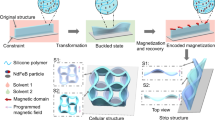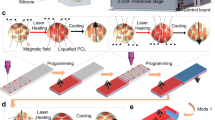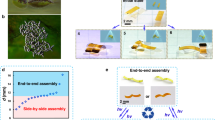Abstract
Polymeric microcomponents are widely used in microelectromechanical systems (MEMS) and lab-on-a-chip devices, but they suffer from the lack of complex motion, effective addressability and precise shape control1,2. To address these needs, we fabricated polymeric nanocomposite microactuators driven by programmable heterogeneous magnetic anisotropy. Spatially modulated photopatterning3 was applied in a shape-independent manner to microactuator components by successive confinement of self-assembled magnetic nanoparticles in a fixed polymer matrix. By freely programming the rotational axis of each component, we demonstrate that the polymeric microactuators can undergo predesigned, complex two- and three-dimensional motion.
This is a preview of subscription content, access via your institution
Access options
Subscribe to this journal
Receive 12 print issues and online access
$259.00 per year
only $21.58 per issue
Buy this article
- Purchase on Springer Link
- Instant access to full article PDF
Prices may be subject to local taxes which are calculated during checkout



Similar content being viewed by others
References
Wilson, S. A. et al. New materials for micro-scale sensors and actuators. An engineering review. Mater. Sci. Eng. 56, 1–129 (2007).
Winey, K. I. & Vaia, R. A. Polymer nanocomposites. MRS Bull. 32, 314–319 (2007).
Kim, H. et al. Structural colour printing using a magnetically tunable and lithographically fixable photonic crystal. Nature Photon. 3, 534–540 (2009).
Jager, E. W. H., Smela, E. & Inganas, O. Microfabicating conjugated polymer actuators. Science 290, 1540–1544 (2000).
Oosten, C. L., Bastiaansen, C. W. M. & Broer, D. J. Printed artificial cilia from liquid-crystal network actuators modularly driven by light. Nature Mater. 8, 677–682 (2009).
Yu, Y. & Ikeda, T. Soft actuator based on liquid-crystalline elastomers. Angew. Chem. Int. Edn. 45, 5416–5418 (2006).
Moniruzzman, M. & Winey, K. I. Polymer nanocomposites containing carbon nanotubes. Macromolecules 39, 5194–5205 (2006).
Saito, S. et al. Development of a soft actuator using a photocurable ionic gel. J. Micromech. Microeng. 19, 035005 (2009).
Smela, E. Conjugated polymer actuators for biomedical applications. Adv. Mater. 6, 481–494 (2003).
Cugat, O., Delamare, J. & Reyne, G. Magnetic micro-actuators and systems (MAGMAS). IEEE Trans. Magn. 39, 3607–3612 (2003).
Fulcrand, R. et al. Development of a flexible microfluidic system integrating magnetic micro-actuators for trapping biological species. J. Micromech. Microeng. 19, 105019 (2009).
Allegra, G., Raos, G. & Vacatello, M. Theories and simulations of polymer-based nanocomposites: From chain statistics to reinforcement. Prog. Polym. Sci. 33, 683–731 (2008).
Yuet, K. P., Hwang, D. K., Haghgooie, R. & Doyle, P. S. Multifunctional superparamagnetic Janus particles. Langmuir 26, 4281–4287 (2010).
Damean, N., Parvis, B. A., Lee, J. N., Odom, T. & Whitesides, G. M. Composite ferromagnetic photoresist for the fabrication of microelectromechanical systems. J. Micromech. Microeng. 15, 29–34 (2005).
Garstecki, P., Tierno, P., Weibel, D. B., Sagues, F. & Whitesides, G. M. Propulsion of flexible polymer structures in a rotating magnetic field. J. Phys. Condens. Matter 21, 204110 (2009).
Kim, S-H., Sim, J. Y., Lim, J. M. & Yang, S-M. Magnetoresponsive microparticles with nanoscopic surface structures for remote-controlled locomotion. Angew. Chem. Int. Edn. 49, 3786–3790 (2010).
Dyab, A. K. F., Ozmen, M., Ersoz, M. & Paunov, V. N. Fabrication of novel anisotropic magnetic microparticles. J. Mater. Chem. 19, 3475–3481 (2009).
Smoukov, S. K., Gangwal, S., Marquez, M. & Velev, O. D. Reconfigurable responsive structures assembled from magnetic Janus particles. Soft Matter 5, 1285–1292 (2009).
Sakar, M. S. et al. Single cell manipulation using ferromagnetic composite microtransporters. Appl. Phys. Lett. 96, 043705 (2010).
Lee, H., Kim, J., Kim, H., Kim, J. & Kwon, S. Colour-barcoded microparticles for multiplexed bioassays. Nature Mater. 9, 745–749 (2010).
Lagorce, L. K., Brand, O. & Allen, M. G. Magnetic microactuators based on polymer magnets. J. Microelectromech. Syst. 8, 2–9 (1999).
Khoo, M. & Liu, C. Micro magnetic silicon elastomer membrane actuator. Sens. Actuat. A 89, 259–266 (2000).
Judy, W. J. & Muller, R. S. Magnetic microactuation of torsional polysilicon structures. Sens. Actuat. A A53, 392–396 (1996).
Judy, W. J & Muller, R. S. Magnetically actuated, addressable microstructures. J. Microelectromech. Syst. 6, 249–256 (1997).
Zhang, L. et al. Artificial bacterial flagella: Fabrication and magnetic control. Appl. Phys. Lett. 94, 064107 (2009).
Yellen, B. B. Magnetically Programmable Transport and Assembly of Colloidal Particles. Thesis, Drexel Univ. (2004).
Ge, J. & Yin, Y. Magnetically tunable colloidal photonic structures in alkanol solutions. Adv. Mater. 20, 3485–3491 (2008).
Ge, J. et al. Macnetochromatic microspheres: Rotating photonic crystals. J. Am. Chem. Soc. 131, 15687–15694 (2009).
Chung, S. E. et al. Optofluidic maskless lithography system for real-time synthesis of photopolymerized microstructures in microfluidic channels. Appl. Phys. Lett. 91, 041106 (2007).
Pregibon, D. C., Toner, M. & Doyle, P. S. Multifunctional encoded particles for high-throughput biomolecule analysis. Science 315, 1393–1396 (2007).
Ge, J. et al. Self-assembly and field-responsive optical diffractions of superparamagnetic colloids. Langmuir 24, 3671–3680 (2008).
Acknowledgements
This work was partly supported by the Korea Science and Engineering Foundation (KOSEF) grant funded by the Korea government (MEST) (2011-0016491), supported by the Korea Science and Engineering Foundation (KOSEF) grant funded by the Korea government (MEST) (2011-0000545), and supported by Global Frontier Project grant (NRF-M1AXA002-2010-0029797) of the National Research Foundation funded by the Ministry of Education, Science and Technology of Korea.
Author information
Authors and Affiliations
Contributions
Jiyun Kim, S.E. Chung and S.K. designed the experiment. Jiyun Kim and S.E. Chung performed the experiments and analysis. S-E. Choi synthesized the magnetic material and gave key advice for the experimental design. H.L. and Junhoi Kim gave key advice for the experimental design. Junhoi Kim also investigated the magnetic properties of the nanoparticles.
Corresponding author
Ethics declarations
Competing interests
The authors declare no competing financial interests.
Supplementary information
Supplementary Information
Supplementary Information (PDF 1594 kb)
Supplementary Information
Supplementary Movie (SWF 25857 kb)
Supplementary Information
Supplementary Movie (SWF 24369 kb)
Supplementary Information
Supplementary Movie (SWF 83033 kb)
Rights and permissions
About this article
Cite this article
Kim, J., Chung, S., Choi, SE. et al. Programming magnetic anisotropy in polymeric microactuators. Nature Mater 10, 747–752 (2011). https://doi.org/10.1038/nmat3090
Received:
Accepted:
Published:
Issue Date:
DOI: https://doi.org/10.1038/nmat3090
This article is cited by
-
Programming structural and magnetic anisotropy for tailored interaction and control of soft microrobots
Communications Engineering (2024)
-
Artificial-goosebump-driven microactuation
Nature Materials (2024)
-
Bioinspired magnetic cilia: from materials to applications
Microsystems & Nanoengineering (2023)
-
Reactive wetting enabled anchoring of non-wettable iron oxide in liquid metal for miniature soft robot
Nature Communications (2023)
-
Magnetic Janus origami robot for cross-scale droplet omni-manipulation
Nature Communications (2023)



